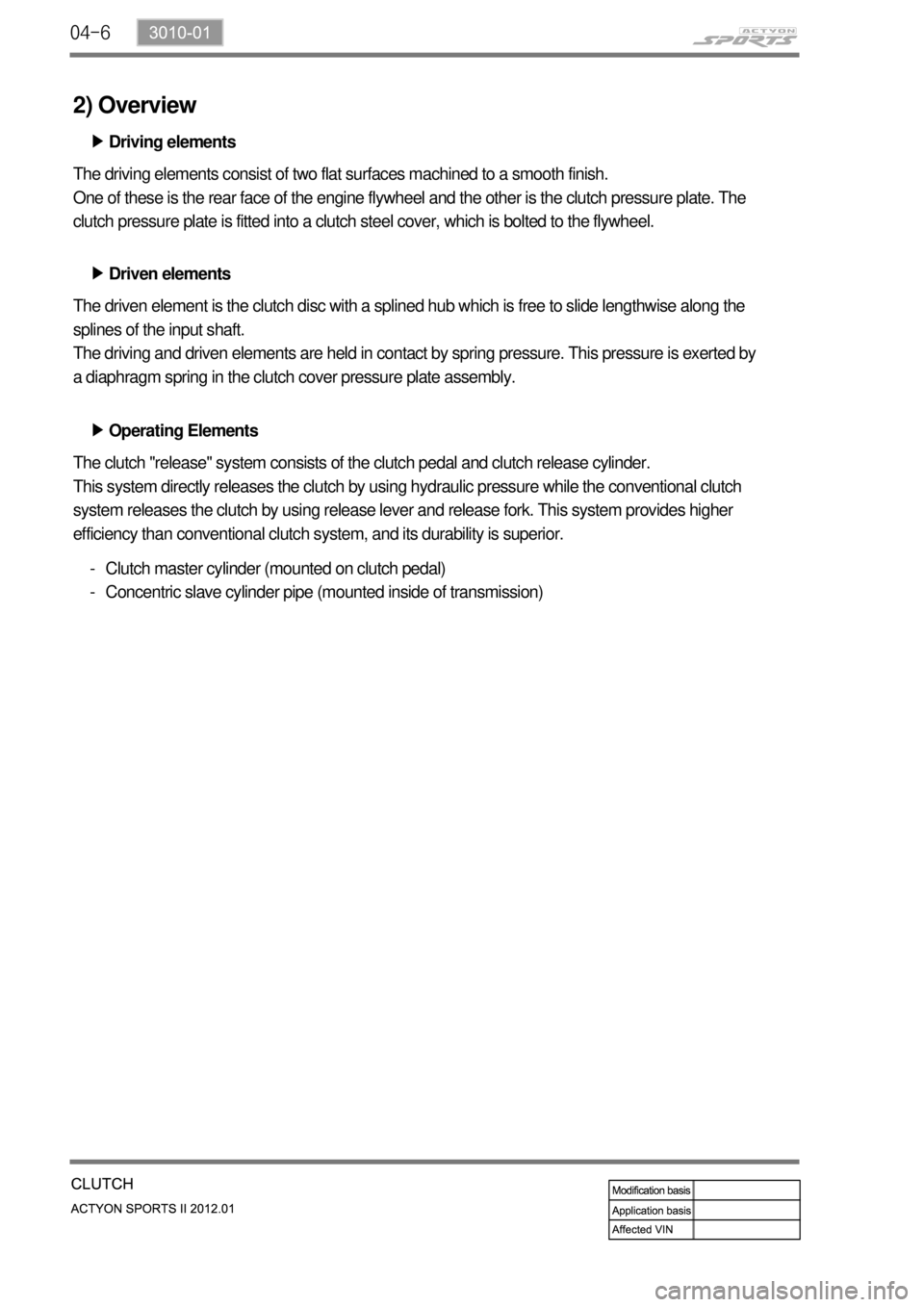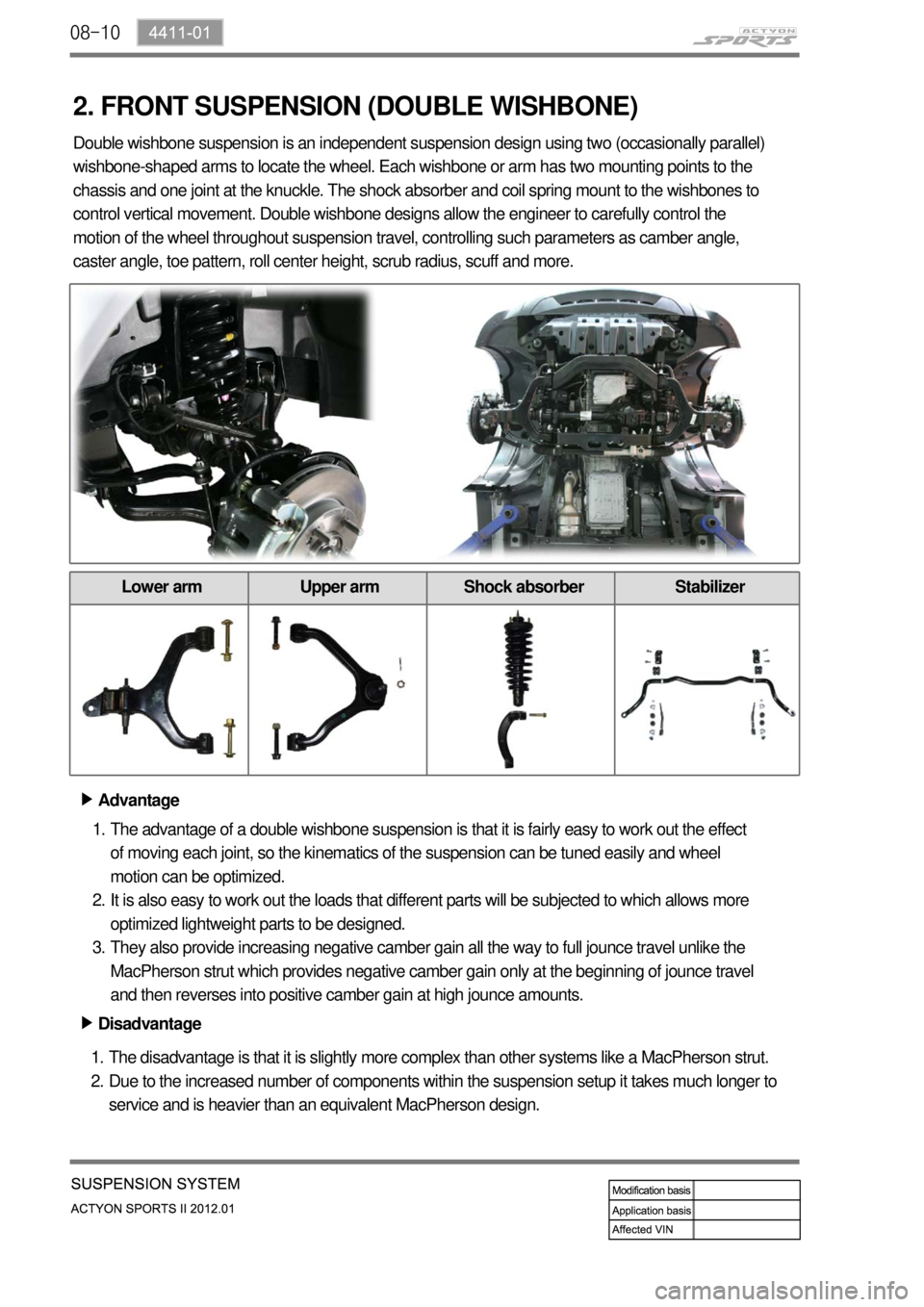Page 615 of 828

03-73170-01
2) Function of N Switch
(1) Aids a smooth start of the vehicle by raising the RPM during the gear
shifting when the engine is cold.
When the vehicle is trying to start from the stopped state (vehicle speed below 3 km/h), the N
switch determines the shifting timing by using the clutch switch and the N switch. It raises the
engine RPM (100 ~ 200 rpm). Operation conditions are as follows.
The vehicle speed is at the stopped state (Vehicle speed below 3km/h detection).
While depressing the clutch (Clutch switch detection).
The gear lever is at a position other than neutral (N switch detection).
Start the vehicle while depressing the clutch pedal (Clutch switch detection).
The RPM increases in accordance with the temperature of the engine coolant
(Engine coolant temperature sensor detection). -
-
-
-
-
appx. 100 rpm increase
appx. 100 ~ 170 rpm increase
<008800970097009f00550047005f005700b6006a0047004f0095009600990094008800930047009b008c00940097008c00990088009b009c0099008c00470096008d0047009b008f008c0047008c0095008e00900095008c0047008a009600960093008800
95009b005000610047008800990096009c0095008b00470059>00 rpm ·
·
·
When the gear has been smoothly shifted and the vehicle speed exceeds 3km/h, it returns to
the previous operation interval of the engine RPM. -
In case of Actyon, the N switch signal is transmitted to the instrument panel, and then the
instrument panel transmits it to the engine ECU through the CAN communication.
Vehicle Made After 04.09.15 Actyon
Page 616 of 828
03-8
Variant Coding Options
(2) Detects the position of the shifting lever for the HDC operation
among ABS functions.
The HDC function operates only if the M/T shift lever is in forward or reverse position. Please refer
to the ABS section for the specific information related to the HDC.
Variant Coding Related to N Switch ▶
The N switch transmits information to the ECU through the CAN communication while New Rexton
is connected to the ECU through wires. Thus, if you set the variant coding in the engine ECU, you
must do it differently, and you must set the variant coding differently according to the vehicle
category and specification as below.
Neutral Signal Input None / Wire / CANWire /
Actyon & Kyron models with
manual transmission
New Rexton model with manual
transmission Manufactured
after 04.09.15
BODY IN: after 154600
Automatic transmission & Rodius
model with automatic
transmission before 2006
Page 619 of 828
04-4
1. OVERVIEW
The hydraulic clutch transmits the force required to operate the clutch pedal to the concentric
slave cylinder fitted to the clutch housing as a hydraulic pressure.
(The hydraulic pressure is transmitted in the following order: Clutch pedal - Clutch master
cylinder - Clutch pipe - Clutch damper - Clutch pipe and hose - Concentric slave cylinder -
Pressure plate - Flywheel.)
If a driver depress the clutch pedal, the hydraulic pressure is generated in the master cylinder. It
is transmitted to the concentric slave cylinder through the pipe, resulting in the cylinder being
forced out. At this time, the clutch disc is forced against the cylinder by pushing the cover. This,
in turn, remove the flywheel from the pressure plate. As a consequence, the power from the
engine will be cut off and the gear change can be carried out.
Page 621 of 828

04-6
2) Overview
Driving elements ▶
The driving elements consist of two flat surfaces machined to a smooth finish.
One of these is the rear face of the engine flywheel and the other is the clutch pressure plate. The
clutch pressure plate is fitted into a clutch steel cover, which is bolted to the flywheel.
Driven elements ▶
The driven element is the clutch disc with a splined hub which is free to slide lengthwise along the
splines of the input shaft.
The driving and driven elements are held in contact by spring pressure. This pressure is exerted by
a diaphragm spring in the clutch cover pressure plate assembly.
Operating Elements ▶
The clutch "release" system consists of the clutch pedal and clutch release cylinder.
This system directly releases the clutch by using hydraulic pressure while the conventional clutch
system releases the clutch by using release lever and release fork. This system provides higher
efficiency than conventional clutch system, and its durability is superior.
Clutch master cylinder (mounted on clutch pedal)
Concentric slave cylinder pipe (mounted inside of transmission) -
-
Page 623 of 828
04-8
3. DUAL MASS FLYWHEEL (DMF)
The dual mass flywheel (DMF) is of having a mass divided into two halves.
While one mass is connected to the engine crankshaft, which is affected by the mass moment of
inertia of the engine, the other mass is affected by one of the transmission.
The divided dual masses are connected to the coil spring and damping system internally.
The DMF has the following benefits: ▶
Reducing fuel consumption by lowering engine speed
Reducing rattling noise and vehicle vibration in all driving ranges
Reducing synchronization wear
Facilitating gear change
Protecting power train parts by preventing excessive load from being delivered -
-
-
-
-
Primary flywheel
Secondary flywheel
Arc damper spring
Torque limiter
Ring gear 1.
2.
3.
4.
5.
Page 646 of 828

08-10
2. FRONT SUSPENSION (DOUBLE WISHBONE)
Advantage ▶
The advantage of a double wishbone suspension is that it is fairly easy to work out the effect
of moving each joint, so the kinematics of the suspension can be tuned easily and wheel
motion can be optimized.
It is also easy to work out the loads that different parts will be subjected to which allows more
optimized lightweight parts to be designed.
They also provide increasing negative camber gain all the way to full jounce travel unlike the
MacPherson strut which provides negative camber gain only at the beginning of jounce travel
and then reverses into positive camber gain at high jounce amounts. 1.
2.
3.
Disadvantage ▶
The disadvantage is that it is slightly more complex than other systems like a MacPherson strut.
Due to the increased number of components within the suspension setup it takes much longer to
service and is heavier than an equivalent MacPherson design. 1.
2. Double wishbone suspension is an independent suspension design using two (occasionally parallel)
wishbone-shaped arms to locate the wheel. Each wishbone or arm has two mounting points to the
chassis and one joint at the knuckle. The shock absorber and coil spring mount to the wishbones to
control vertical movement. Double wishbone designs allow the engineer to carefully control the
motion of the wheel throughout suspension travel, controlling such parameters as camber angle,
caster angle, toe pattern, roll center height, scrub radius, scuff and more.
Lower arm Upper arm Shock absorber Stabilizer
Page 657 of 828
09-94850-01
Problem Cause Action
Burning smell
around tireToo frequent braking in high driving speed Reduce the use of
foot brake/use
engine brake
properly Used only foot brake during downhill driving
Driving with foot on brake pedal Get off the foot
from pedal
Foreign materials such as dirt or sand in brake system Replace: caliper,
wheel cylinder,
master cylinder,
return spring
Broken return spring in shoe assembly Replace
Incorrectly adjusted parking brake cable Adjust
Incorrect wheel or wheel cover
(generating the heat)Replace
Page 658 of 828

09-10
This section describes the noise phenomena occurred possibly in the brake system operation.
Distinguish between the information given below and the actual problems and then, inspect the
vehicle and take appropriate measures.
Noise symptoms and Causes -
Symptom 1. If depressing the brake pedal when the engine is cold, "screeching" sound always
occurs and, after driving for a while, the sound disappears..
This usually occurs in the morning. When the temperature goes down, the dew condensation
phenomenon sets moisture on the brake disc as the window frost forms. Due to this moisture, the
iron within the brake disc and pad oxidizes, forming undetectable micro-rusts on the disc
surface. When starting the engine under this condition, noise may sound due to the friction of
micro-rusts. When operating the brake several times, the disc temperature goes up and the
micro-rusts come off and the noise goes away. Depending on the driving conditions, noise gets
louder when slightly depressing the brake pedal and oppositely, noise is smaller when deeply
depressing the brake pedal. This is simply a physical phenomenon, called "morning effect" in
professional terms, and does not imply any problems with the brake system.
Symptom 2. Slip or screech after the brake pad replacement.
This usually occurs when the bed-in is not made between the disc and the pad's friction material.
The bed-in is a state that the brake system normally works and gives no noise out, when, after
about 300 km city driving, the contact area of the pad friction material is enlarged and the disk is
in complete contact with the pad's friction material. Therefore, for some time after the brake
disk/pad replacement, the brake system poorly operates or noise (abnormal sound) occurs due
to the partial contact.
Symptom 3. "Groaning" sound occurs in the automatic transmission vehicle when slightly taking
the foot off the brake pedal to slowly start after waiting for the signal, or slightly depressing the
brake pedal.
This is the noise "Creep groan" that occurs when, in both the automatic and manual transmission,
slightly releasing the brake pedal in the neutral gear at downhill roads.
It frequently occurs at the low braking power and low speed, through the following process. When
operating the brake system at low speed and low pressure, adhesion and slip repeatedly take
place between the brake disk and the friction material, and this makes the braking power
inconstant, instantly increasing or decreasing, and gives out the brake noise.
It is also a physical phenomenon and has no relation with the brake performance.BRAKE OPERATION AND NOISE ▶